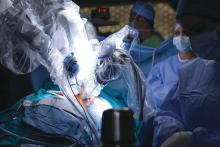LAS VEGAS – Colorectal surgeon Jamie Cannon, MD, doesn’t think there’s a rivalry between laparoscopic surgery and robotic surgery. Instead, she told colleagues, they should be seen as parts of the same whole: “Robotics is laparoscopy. It’s just a tool that allows us to do laparoscopic surgery better.”
Specifically, robotic surgery deserves a prominent place in treatment for rectal cancer, Dr. Cannon, associate professor of surgery at the University of Alabama at Birmingham, said in a presentation at the Annual Minimally Invasive Surgery Symposium by Global Academy for Medical Education.
“We can reduce the conversion rate and offer more complex patients a minimally invasive operation,” she said.
Dr. Cannon listed these benefits of robotic surgery:
• Better cameras offer 3-D visualization.
• A stable operating platform provides tremor control.
• Instruments are fully articulated.
• The ability to perform fine dissection and complex suturing in confined spaces is enhanced.
• Ergonomics are improved.
“From a surgeon’s standpoint, it’s a lot more fun and a lot more comfortable,” she said. “You’re sitting there rather than straining your neck and arms to accomplish something difficult.”
Statistics show that robotics is gaining on open surgery in anterior rectal resection procedures while laparoscopy remains flat, she noted. In 2008, she said, the percentages for open, laparoscopic and robotic procedures were 81%, 18% and 1%, respectively. In 2015, they were 60%, 20% and 19%, respectively.
According to Dr. Cannon, other benefits of robotic surgery in rectal resections include better outcomes in difficult patients and lower conversion rates.
A 2017 prospective, randomized study did not show a difference between laparoscopic and robotic approaches to conversion rates in rectal resection, she noted (JAMA. 2017;318[16]:1569-80).
However, she said, a newer study presented at the Academic Surgical Congress in 2018 did show a major difference, with a conversion rate of 17% in laparoscopic procedures (n = 128) and 1% in robotic procedures (n = 92, P less than .05). Conversion rates in obese patients were similar.
In regard to obese patients, “we know they don’t do well,” Dr. Cannon said. “One thing we don’t always talk about is the impact on surgeons. These cases are very difficult to do.” Robotic technology allows surgeons to “make up for the challenges you experience laparoscopically” in these procedures, she said.
Robotics can be helpful because they allow surgeons to offer minimally invasive surgery to patients who pose challenges because of morbid obesity, inflammatory conditions such as Crohn’s disease and enteric fistulas, and histories of multiple previous surgeries, she added.
Global Academy for Medical Education and this news organization are owned by the same parent company. Dr. Cannon disclosed serving as an instructor for Intuitive Surgical.

